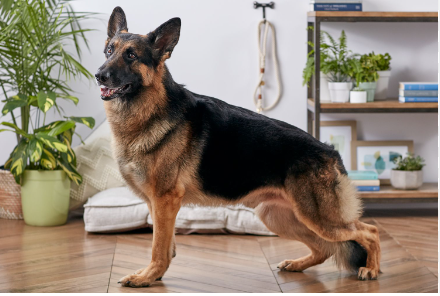Welcome to the world of Blue German Shepherd – a unique and striking variation of the classic German Shepherd breed. With their striking blue coats and loyal personalities, these dogs have captured the hearts of many pet lovers around the world. In this blog post, we will delve into what makes Blue German Shepherds special, their history, temperament, suitability as family pets, care tips, potential health concerns, and ultimately help you decide if they are the right furry companion for your family. Let’s embark on this exciting journey together!
The History of Blue German Shepherds
Blue German Shepherds have a fascinating history that traces back to the traditional German Shepherd breed. The distinct blue color variation emerged due to a recessive gene inherited from their ancestors. Originally, this unique coloring wasn’t widely accepted by official breeding standards, but over time, it gained popularity among enthusiasts.
The striking blue hue in these dogs is not only aesthetically pleasing but also adds a touch of uniqueness to the already impressive German Shepherd lineage. Despite some controversy surrounding their breeding practices, Blue German Shepherds have carved out their niche in the dog-loving community.
Their journey from being an unconventional variation to gaining recognition as a sought-after pet demonstrates the resilience and adaptability of this remarkable breed. As they continue to capture hearts with their stunning appearance and loyal nature, Blue German Shepherds stand as a testament to the rich history and evolution of canine companionship.
Characteristics and Temperament of Blue German Shepherds
Blue German Shepherds are known for their striking appearance, with their unique blue coat setting them apart from the traditional black and tan coloration. In addition to their mesmerizing looks, these dogs possess a range of characteristics that make them stand out as loyal and intelligent companions.
These dogs are highly trainable and eager to please, making them ideal for families looking for a devoted pet. Blue German Shepherds are known for their strong work ethic and excel in various roles such as search and rescue, police work, or serving as therapy animals.
When it comes to temperament, Blue German Shepherds are typically confident, courageous, and protective of their loved ones. They form strong bonds with their family members and can be affectionate towards children when properly socialized from a young age.
Blue German Shepherds combine beauty with brains, making them excellent companions for active families who are willing to provide plenty of exercise and mental stimulation.
Are They Good Family Pets?
When considering a Blue German Shepherd as a family pet, their loyalty and protective nature shine through. These intelligent dogs are known to form strong bonds with their families, making them excellent companions for households seeking a devoted four-legged friend.
Blue German Shepherds are alert and vigilant, always ready to protect their loved ones. Their natural instincts make them great guard dogs, keeping an eye out for any potential threats while also being gentle and affectionate towards family members.
With proper training and socialization, Blue German Shepherds can thrive in a family environment. They are highly trainable and eager to please, making them adaptable to various living situations.
However, it’s essential to consider the energy levels of these dogs. Blue German Shepherds require regular exercise and mental stimulation to prevent boredom or destructive behaviors. Active families who enjoy outdoor activities will find a perfect match in these athletic canines.
Tips for Owning a Blue German Shepherd
When owning a Blue German Shepherd, it’s essential to provide plenty of exercise and mental stimulation. These intelligent dogs thrive on challenges like obedience training or interactive toys. Establishing a consistent routine will help them feel secure and well-behaved.
Socialization is key for Blue German Shepherds to interact positively with other animals and people. Exposing them to various environments from an early age can prevent behavioral issues in the future.
Proper grooming is crucial to maintain their beautiful blue coat. Regular brushing helps reduce shedding and keeps their fur healthy. Additionally, regular veterinary check-ups are important to monitor their overall health and catch any potential issues early on.
Setting clear boundaries through positive reinforcement training will help your Blue German Shepherd understand expectations in the household. With patience, love, and proper care, owning a Blue German Shepherd can be a rewarding experience for any family willing to put in the time and effort needed for these loyal companions.
Potential Health Concerns
As with any dog breed, Blue German Shepherds may be prone to certain health concerns that potential owners should be aware of. One common issue seen in this breed is hip dysplasia.
A condition where the hip joint doesn’t fit properly into the socket, leading to pain and mobility issues.
Another health concern to watch out for in Blue German Shepherds is degenerative myelopathy, a progressive disease of the spinal cord that can result in hind leg weakness and paralysis. Regular exercise and proper nutrition can help mitigate these risks.
It’s also important to keep an eye on your Blue German Shepherd’s weight as obesity can exacerbate existing health conditions. Regular vet check-ups and preventative care are key in ensuring your furry friend stays healthy and happy for years to come.
Making the Decision About Getting a Blue German Shepherd as a Family Pet
After exploring the history, characteristics, temperament, tips for ownership, and potential health concerns of Blue German Shepherds.
it’s clear that they can make wonderful family pets. Their loyal nature, intelligence, and protective instincts can be great assets in a household setting. However, it’s important to consider the commitment required to properly care for a Blue German Shepherd.
Before deciding to bring one into your home, ensure you have the time and resources to dedicate to their exercise needs and training requirements. Additionally, be prepared for potential health issues that may arise due to their breeding. If you’re willing to put in the effort and provide a loving environment for a Blue German Shepherd.
They can undoubtedly become a cherished member of your family.
